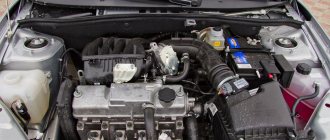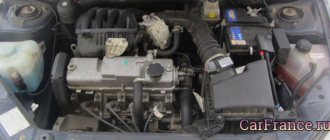The cooling system built into the power unit of the popular domestic bestseller Lada Granta, which has 8 valves, has a traditional design. Among the most important components of this unit is the pump (pump). The engine modifications offered in the “Grant Configuration Plan” have the following factory designations:
- "VAZ-11183";
- "VAZ-11186";
- “VAZ-21126” (same for automatic transmission);
- "VAZ-21127".
The pump must be replaced correctly; the choice must be made based on the data in the catalogs. The correct choice of part is a very important aspect of engine safety, since the “safety” of the timing belt depends on the pump (its functionality). Well, which pump to choose is up to you.
Next, we will clarify the catalog code of the component in question. It looks like this: 21114-1307010-00 or 21114-1307010-01.
You can check the degree of wear of the product and the need to replace it with your own manual manipulations. To do this, you can limit yourself to visual observation. If this measure does not lead to the desired result, the element must be disassembled to finally verify the presence of cracks or wear. In this case, the pump must be replaced.
Next, let’s look at the characteristics, the presence of which “classifies” an element as not to be used:
- noise created by a worn bearing;
- signs of leaks indicating damage to the seals;
- if wear or breakage of the impeller is detected, this fact will be confirmed by insufficient circulation of liquid in the cooling circuit (increase in temperature);
- the appearance of axial play on the shaft can also reliably indicate a “dead” bearing.
All this signals the need to replace the pump.
Purpose and recommendations
The pump serves to ensure correct and sufficient fluid circulation in the cooling circuit of the Lada Granta engine, which has 8 valves. The element requires periodic attention, which will allow the system to operate for a long time without sudden and unpleasant surprises. Ignoring the control input may result in sudden damage, which will inevitably lead to overheating of the engine.
A high-quality product has a positive effect on the performance of the heating system of the Lada Granta 8-valve version. The presence of counterfeits is very common, so it is worth checking in advance and discussing with the seller when to return a low-quality product.
Which pump to choose? For the Lada Granta model, we recommend choosing an 8-valve pump between two manufacturers that have earned the trust of motorists, namely:
- TZA (Togliatti inert (Lugansk plant of automobile radiators).
An important aspect of the choice is to focus on the colors that are present on the cases of the original products. It will also be useful to compare the grooves and stiffeners made on the impeller. We recommend that you carefully check the entire list of markings and inscriptions with those on the original products.
Today the market can offer an impressive range of these products for Lada Granta, which has 8 valves. A guaranteed option to avoid a collision with a fake is to take the original pump with you. The lack of experience in dealing with spare parts for such an aircraft can play a bad joke on the buyer.
Which pump should I choose? You can purchase a pump from an official dealer, and if this option is not available, below are recommendations for the following analogues with a price parameter:
- "TZA" (code 21116-1307010-00) at a price of 815-1100 rubles;
- “LUZAR” (No. 21116-1307010-00), around 1240 rubles;
- "Kraft" with a price of about 1550 rubles;
- “HEPU”, the most expensive option (1800 rubles).
There is an opinion that the “original” can be found on the market at a dubious price, from 500 rubles. However, the authenticity of the product cannot be guaranteed, so it is the buyer's sole responsibility to exercise caution in this step.
How to replace a part on an 8 and 16 valve unit?
For the repair process, that is, when replacing the pump, you need to acquire the simplest tools, namely:
- different screwdrivers;
- keys size “10” and “17”.
- Disconnect on-board power from the battery.
- We install the piston of the first cylinder in the traditional TDC position on the LADA Granta model.
- We disassemble the tensioner roller together with the timing belt, having first turned off its tension.
- Remove the pulley from the crankshaft.
- Remove the cover protecting the drive distributor.
- Unscrew the pump mounting bolts. Don't forget to drain the liquid first!
- We remove the pump from the cavity of the motor unit housing (with a screwdriver).
- Do not forget about the mandatory replacement of the gasket!
- We install the new product on site, observing its correct orientation (number up).
Important! We do not turn the crankshafts (timing and crankshaft) so as not to break the label.
Signs and causes of failure
You can identify a broken part by the following signs:
- insufficient circulation of coolant and, as a result, frequent overheating of the engine;
- presence of smudges at the pump mounting location.
hum of bearings at the pump mounting location;
These markers indicate the most likely causes of malfunctions in the Grants pump:
- bearing wear or damage;
- damage to the seal;
- worn sealing gasket;
- broken pump impeller.
In most cases, the part becomes unsuitable for major repairs and requires a complete replacement. Ignoring pump problems leads to replacing the timing belt and replacing components of the connecting rod and piston group. Valves and bearings may also need to be replaced.
Pump replacement completed
Note that 8-valve Lada Granta units suffer from the risk of belt breakage due to jamming of a previously diagnosed and replaced pump. On these units, the pump life is close to 80 thousand strokes, with a warranty of one year. Here you should be careful and choose only high-quality spare parts.
There is disagreement among Lada Grant owners about the need to cover the new gasket with a sealing compound or the absence of such an action. Pump manufacturers say this is not necessary! Many craftsmen neglect this postulate and add sealant, explaining this as a better sealing of the cooling channel in which the pump is located.
When replacing, we focus on some important aspects:
- do not blow out the camshaft pulley key;
- We block the crankshafts after removing the belt, preventing their rotation.
Engine VAZ-21116
Consequences of a broken timing belt on an eight-valve VAZ-21116 engine.
The pistons show clearly visible marks from the impact of the valves. Consequences of a broken timing belt on an eight-valve VAZ-21116 engine. The pistons show clearly visible marks from the impact of the valves.
And it’s a no-brainer: if you change the belt, tension rollers and pump in time, then the risk of destruction, and even if it is not reduced to zero (adjustment for low-quality components), will become significantly less.
Feature of the replacement on 8-valve versions of the VAZ (“11183” - 82 hp and “21116” - 87 hp)
Before replacing the pump, we ensure that tools are available that are similar in composition to the procedure discussed previously.
- In accordance with safety precautions, we disconnect the battery.
- Drain the liquid from the cooling circuit.
- We proceed according to the above sequence.
The process is very similar to the actions on the 16-valve version of LADA Granta. The only difference will be in the attachment of the dispensing covers. When replacing the pump, remember that you need to replace the gasket, which will give you a sense of security in terms of ensuring sufficient tightness of the system on your LADA Granta.
In most cases, the gasket material is paronite. It is advisable not to neglect and cover the gasket with sealant.
Let's sum it up
Now you know which pump to choose the best. They strive to quickly diagnose and replace the coolant pump on LADA Granta. Use only high-quality products that will allow the assembly elements to work for a long time and correctly. Take the time to compare different products in different offers, this is a reasonable action in terms of choosing the best option.
Lada Granta 2012
- Thank you all! I am sure that this article will be very useful to owners of Lada Granta with engine 21116 installed on cars with the “norm” package. Before this article there were 3 of them, I deleted them and decided to write this one so as not to confuse the chronology of events!
Let's start with the fact that my typewriter is one year old. This year there was little pleasant and little. I ran 31 thousand kilometers. The main mileage was in the municipal district of Kashira, Stupino, Moscow, several trips to Tula.
I have been tormented for a long time by a strange knocking noise from the engine when cold. I didn’t cause any particular panic, as the engine warmed up and the ticking disappeared. And at 29,000 km, it stopped being felt to the touch after warming up and even made a cracking noise when starting off. Alternator, exhaust system, CV joint, front bumper and this is not a complete list of what I checked. The pump and automatic timing belt tensioner remained, they opened the cover, but did not see anything suspicious. I went to the service to see my friends with a more knowledgeable gaze. The pump said by the sound, opened the timing case and probably the timing belt runs along the pulleys. What frightened me most of all was this diagnosis, since there are no spare parts for the Lada Granta at all. I surfed the forums and Drive2, found a couple of cases where the pump was installed from the previous ones, they said that it differed only in the width of the pulley, and even then not much.
And so it was necessary to buy:
— Water pump 2170;
— automatic roller tensioner of the toothed belt 2190;
— timing belt 2190;
To my surprise, the timing belt for Grant was in almost every store, with a roller and a pump for ambush bags, as expected, the delivery time of the order is not unknown.
I asked the store to show the pump of the nines and the priors, I didn’t immediately notice the difference except for the width of the pulley, and I got sick from the nines.
Why can’t you install a nine pump on the Lada Granta 21116 engine:
If you take a quick look at the VAZ-21116 and VAZ-210914 pump, I assure you, you will not notice the difference, the VAZ-210914 pump will have a slightly different impeller and will not have a small threaded hole for tightening the case, but this is not a problem, the main difference is in the gear pulley On the VAZ-21116 engine, the pulley migrated from the previous VAZ-21126, only it became a little tighter. On the Priora, the pulley comes with rounded teeth, and on the VAZ-210914 - with rectangular ones, and even more so they are a couple of millimeters higher; by installing this pump on the VAZ-21116 engine, you will push the timing belt and last ten times less. At the time of purchase I didn’t know and bought from nine.
Because it is not recommended to install an automatic tensioner roller on the VAZ-21116 Priora VAZ-21126 engine
The roller that I bought from the previous Pilenga PT-P 1570s turned out to be the same by eye, with the exception of a bolt hole on the side of the motor mount. When I made my video, I realized there was a big difference! Firstly, the original skating rink 21116 is larger in diameter, and secondly, it is already there. The plastic housing of the previous roller is wider and fits against the motor, this is solved by grinding the excess with a sander or, as I did, a sander. There is another difference in one detail: the thickness of the metal body of the roller is wider than that of the Priora, and therefore if you install it from the Priora you still need to install a washer. My conclusion is not optimistic: since the roller has flaps of smaller diameter than guaranteed, it is necessary to pull it beyond the mark when stretching the roller and thereby effectively denying it the automatic adjustment range.
Replacing the timing belt, roller and pump. Attempt No. 1
All purchased spare parts are collected in one package:
— automatic roller tensioner 21126 (2170) Pilenga PT-P 1570;
— Timing belt VAZ 21116 (2190) Original 5670XS
— Water pump VAZ-210914, TZA 21091307010-75
Total 2540 rub.
Previously, I myself did not have to change times; I had no time to study, and I decided to take it into service. Everything was decided there. There is a pump, there is some play, but not so critical! Why did the timing belt bend? It's not clear yet.
The bearing is also in very good condition, as is the belt! I put the original parts in the trunk and installed new ones. I start the car and hooray! The shot went through, the belt was like a glove! I paid 2000 rubles and went home happy.
In total, replacing consumables once cost me 4,500 rubles, thanks to the guys from AvtoVAZ.
You probably thought that everything was fine, the pump was replaced and now the car is like new. No, no, no.
I went home and decided to inspect the engine compartment, everything is fine, except the alternator belt is too tight, well, there is nothing to adjust the tension, check and go home (remember this point).
In the morning he started to leave and the knocking sound appeared again, he tried to move, and then a crash followed! Disappointed, I got to work. At work I have a lot of thoughts on this topic, and then I come across a forum and pictures on the Internet! Show photos of water pumps and pulleys from Apriori and Nine and show the difference! I just have a hurricane of thoughts in my head. After work, I fly home, open the timing belt and yes. The belt is clearly jammed. On the front you can see the teeth marks.. they change again.
Replacing the timing belt, roller and pump. Attempt No. 2
This time I waited until the weekend; the time to find the wrong pump was Thursday. Until Saturday he had covered just over 200 km. In total I drove about 400 km. This time I decided to change everything myself. I went to the store again and bought a pump and timing belt.
I put the parts in a bag and went home, it was a sunny day, I decided not to even take it to the garage.
— Water pump TZA 21121307010-75
— Timing belt VAZ 21116 (2190) Original 5670XS
Total 1030r + 740r = 1770r.
I will not describe the process of replacing the pump and timing belt, since there is a lot of literature on repair and operation, which, by the way, I use myself.
What is the difference between the water pump VAZ-21116 and VAZ-21126.
They differ only in the width of the pulley and again, slightly. The video was left to his family; he did not take any risks with Priorovsky, especially since his conditions were ideal.
I used a flat-jaw circlip puller as a wrench to tension the roller. The time was set immediately and without problems.
I saw from someone on Drive2 that the pump from the previous ones clings when the timing case is tightened tightly, I did not observe this, I even noticed by eye a small gap between the pump pulley and the casing.
The engine knocks and squeaks when starting.
We set the timings, started the engine, the belt remained in place, we clearly liked the car pump from the previous ones! =) BUT! When leaving there was a knock and a crash. the smile disappeared from his face, but appeared after 10 minutes of digging in the engine compartment! Remember, I told you to remember the moment when I loosened the tension on the alternator belt! Like! The first time I changed the timing belt at the service center, they pulled the alternator belt very tightly on me and pressed the alternator, and as a result the sound disappeared! When I got home, I relieved the tension and in the morning the sound appeared again! This is the whole mystery!
Now the solution: my gaze was directed to the empty hole, the hole in which the lower bolt securing the generator to the bracket should sit (a long bolt), the bolt is not there! Damn, I knew I'd find out where the crackling noise was coming from and that it wasn't a design feature of the car! I began to look and understand that for some reason the bolt had unscrewed and flown off. Of course, there were sins behind me when I forgot to tighten up the details, but this happened 3-4 times in my life, it’s impossible here, since I was in no hurry and dug in search of pleasure!
I inserted a new bolt, installed a check washer, now I think it won’t go anywhere! How did I not notice this before?! Running and quiet, the car drives like new! Wow, and she fucked me.
There is another unsolved mystery in this article! Since the timing belt was running on the pulleys, I wouldn't say my own pump suffered much damage. Well, ok now everything works pah-pah. I live outside the city, getting to car shops by public transport is problematic, it’s good that there is a Daewoo Matiz 1.0 Best, it helps me.
I bought it together with Grant at the same time. The mileage on the Matiz is 24,540 km, only oil and filters. Why are the Uzbeks better than us?
In total, with all the jambs, changing the timing belt cost me 6,270 rubles. tube The car has driven only 30,000 km.
Why are the French and Japanese silent? Renault + Nissan ayyy! Why are there no spare parts on store shelves? Why did the timing belt run along the pulleys for 30,000 km?
Lada Granta cars have rightfully earned a reputation as reliable and easy-to-maintain vehicles. Drivers generally speak well of this model, and besides, all the procedures necessary to restore functions or replace units on the Grant can be easily carried out manually. The list of independent work also includes dismantling a failed pump.
How long does it take to change the pump on a grant?
To avoid being blown up by a mine, it is enough to know where it is laid. Let's play sapper and find out when you really need to change coolant pumps and timing belts on VAZ engines.
Domestic engines for Grant, Kalin, Prior, Vest and Iksreev, with the exception of VAZ-11183, belong to the “plug-in” category. What this means is that when the timing belt breaks, the pistons meet the valves. Read - it exploded and led the engine to destruction, which was expensive to repair.
With Vesta and Xray, progress is obvious - at 45, 75, 105, 135 and 165 thousand we adjust the gaps in the gas distribution mechanism. And for the first time we plan to remember the timing belt along with the rollers for 180 thousand kilometers! This is for 16-valve engines VAZ-21129, 21179 and 8-valve Vesta VAZ-11189. I can’t do without the quote: “2.11. Replace the timing belt along with the rollers. 2.12. Replace the crankshaft and camshaft sprockets. Replace the toothed belt, tensioner and support roller (for the VAZ-11189 8-cl. engine, only the tensioner) of the engine gas distribution mechanism drive. Adjust the tension of the toothed belt." Not only is the oil oil (we change the same belt twice), but of all the parts, they didn’t remember the most vulnerable one - the pump!
New VAZ engines are now equipped with high-quality timing belts from well-known brands. I believe that if no oil gets on it, it will cost 180 thousand. But is the difference in components really so great that on the 8-valve VAZ-11186 for Granta the belt must be changed at the 75th thousand, and on its closest relative VAZ-11189 at the 180th?
Let's continue the research. The pulleys are not demolished at all. Pressure roller bearing up to 180 thousand? Let's admit it, although it's hard to believe. But why change all this equipment at the 180th thousand, if the estimated life of the engine is 220 thousand km? Refresh before demise or major overhaul? If you don’t believe me, look at the photo taken in the workshops where VAZ engines are produced.
I don’t want to once again convince you that the stingy pays twice, but over the years I have come to the conclusion that Western manufacturers include in the regulations changing the belt not because of the belt as such, but because of the pump and tensioner bearings. They just needed a reason to reliably replace the entire set of parts associated with the camshaft drive, and they found it.
I propose to do the same with our engines. Why? Formally, at each maintenance it would be necessary to remove the cover and inspect the timing belt and water pump. You can see a tear in the belt, as well as a leak on the pump. In both cases, the part is changed without delay. But this is a malfunction. And if everything is outwardly normal, the ideal option is to include preventive replacement in the regulations.
Replacing the pump (water pump) on a Lada Granta is done in two ways: if the pump “hangs” on the timing belt, then by replacing the timing belt, if separately from the belt, then without removing the timing belt. Replacing the pump on a Lada Granta can only be entrusted to a motor mechanic at a car service center. It is strictly not recommended to change it yourself.
Along with replacing the pump on a Lada Granta, it is necessary to change the gasket of the pump (water pump). When purchasing a pump, pay attention to whether the pump gasket is included. In cheap pumps, the gasket is sold separately. When replacing the pump on a Lada Granta, it is better to immediately replace the antifreeze. You should not decide to replace the pump yourself. Do a diagnostic of the cooling system, the mechanic will be able to accurately determine whether it is the pump or not and will guarantee that replacing the pump will correct the problem.
Cost of replacing a water pump (water pump) on a Lada Granta:
| Replacement options | Replacement | Pump price |
| Replacing the Lada Granta pump, without timing belt | from 2,000 rub. | from 1,100 rub. |
| Replacing the Lada Granta pump, with timing belt removed | from 4,500 rub. | from 1,100 rub. |
In terms of time, replacing the pump on a Lada Granta takes from 2 to 12 hours, depending on the engine size.
Pump replacement warranty
- 180 days.
Rating of Lada Granta pump manufacturers based on owner reviews: 1. Graf (Italy) 2. Airtex (Spain) 3. SKF (Sweden) 4. Luk (Germany) 5. Ruville (Germany)
When you need to change the pump on Lada Granta:
— backlash of the pump drive pulley; — extraneous sounds from the pump; - leaks on the pump; — the antifreeze leaves, but no leaks are visible.
Engine Lada Granta
The main defects of the Lada Granta water pump are coolant leaks and bearing wear (determined by increased noise and hum during operation). Repairing a water pump, as a rule, does not lead to the desired result, so it is recommended to replace the pump assembly.
You will need: keys “10”, “17”, two screwdrivers.
Why do you need a pump in a car?
The power unit of any vehicle works in close connection with the cooling system. Constant circulation of antifreeze (or antifreeze) through the system ensures proper engine cooling and protects engine rubbing parts from overheating. Consequently, if there were no cooling system, the engine could not be considered a working unit: at the first load it heats up to a critical temperature and boils.
The operation of the cooling system fits into a simple scheme:
The driver pours antifreeze into the expansion tank.
After starting the engine, antifreeze begins to flow into the pump cavity.
From there, the pressurized fluid is directed to the radiator assembly and cylinder block.
As a result, the pump in this scheme plays the role of pumping equipment, which ensures uninterrupted supply of coolant to the engine.
The device is made of hard metal alloys, which allows you to extend the service life of all moving and rubbing parts of the pump
On the Lada Granta the pump starts when the engine is turned on. The pump itself is part of the gas distribution mechanism: its impeller blades will rotate until the pulley rotates through the timing belt.
Signs of a pump malfunction on a Lada Granta car
"Lada Granta" continues the best traditions of the automotive industry of the domestic plant, so its design does not cause any particular difficulties in diagnostics. To identify a pump malfunction, there is no need to consult the instruction manual or contact service. There are only three signs of a water pump malfunction that the driver can identify on his own.
The engine started to get very hot
If the Granta starts to get very hot even in winter while driving and the fan can no longer cool the engine, then this is a clear sign that the pump has failed. The fact is that the presence of coolant in the system does not yet guarantee engine cooling, since in the absence of pressure the liquid simply will not flow to the cylinder block.
Suspicions can be confirmed quite simply:
Wait until the engine warms up to operating temperature.
If only cold air begins to escape, the circulation of antifreeze in the system is interrupted. Most likely, the problems are associated with severe wear of the pump impeller blades, and therefore it is necessary to replace the pump with a new one as soon as possible.
Instrument readings in the cabin indicate that the engine is warming up strongly - this is a reason to look under the hood and check the condition of the pump
Timing belt wears unevenly
Often drivers, having decided to change the timing belt, are surprised to notice that it is worn only on one side. Of course, this is not normal for a rubber product - the timing belt design is designed for uniform planned wear of each part.
The timing belt rubs on one side due to loose bearings on the pump shaft. Therefore, if there is asymmetrical wear on the timing belt, it is an indication that the pump is about to fail. Typically, if the bearings are loose, the driver will hear a loud creaking or knocking sound from under the hood while driving.
Even after a short time, the belt will begin to wear out on only one side, if the pump bearings wear out
Pump leaking
Even a quality water pump cannot last forever. Therefore, over time, the pump seal (the most vulnerable element of the pump) will begin to wear out and, as a result, leak. And the loss of antifreeze in the timing belt area clearly indicates that the pump has lost its tightness and no longer performs its function to the required extent. Of course, if the leak is small, the car can still be used as the system will continue to keep the engine cool. However, at any moment the oil seal can completely burst and all the antifreeze will flow out of the crankcase.
In some cases, water pump leaks are observed not only due to wear of the oil seal, but also due to improper installation of the rubber seal when replacing the pump.
Abundant release of antifreeze in the distribution unit indicates depressurization of the water pump
Korean-made coolant pump for VAZ-21179 engine
The owner of any elderly foreign car with a timing belt will confirm that repairmen insist that during a scheduled belt change, they replace both the pump and the pressure rollers with bearing assemblies. And these parts are often sold as a set. Moreover, at a discount - the whole set is cheaper than the belt, rollers, and pump separately.
I don’t want to once again convince you that the stingy pays twice, but over the years I have come to the conclusion that Western manufacturers include in the regulations changing the belt not because of the belt as such, but because of the pump and tensioner bearings. They just needed a reason to reliably replace the entire set of parts associated with the camshaft drive, and they found it.
I propose to do the same with our engines. Why? Formally, at each maintenance it would be necessary to remove the cover and inspect the timing belt and water pump. You can see a tear in the belt, as well as a leak on the pump. In both cases, the part is changed without delay. But this is a malfunction. And if everything is outwardly normal, the ideal option is to include preventive replacement in the regulations.
Replacing the water pump on Grant (8 valves)
The driver can change the pump on an 8-valve Lada Grant without going to a service station. The main thing is to follow the replacement instructions, and after completing the replacement, set the crankshaft and pulley values correctly. Typically, the timing belt is replaced along with the water pump.
Where is the pump located?
Since the pump is started by a gas distribution mechanism, it is quite obvious that it will be integrated into the distribution system. That is, you need to look for the location of the pump on the Lada Grant on the right side of the engine.
Before removing the timing belt, it is impossible to visually see the pump - only the pump pulley is visible, which just starts the impeller.
The water pump is part of the timing belt
Preparing tools
To work, you will need several wrenches, standard auxiliary tools and materials:
key 10;
head socket 10;
key 17;
a screwdriver with a flat and thin blade;
container for draining coolant (at least 10 liters);
Replacing the pump on a Lada Grant does not require special tools: a standard set of tools is enough
How much coolant should be drained and refilled when replacing
Regardless of the availability of time or desire of the driver, draining the antifreeze will still be required when replacing the water pump. This is necessary to relieve existing pressure in the cooling system and protect against possible risks. However, the main question is how much liquid needs to be drained.
Traditionally, when replacing a pump, the entire volume of antifreeze is drained, since the new water pump will require new coolant. However, if new antifreeze was added very recently, there is no point in changing it. It is enough to drain 4-5 liters of fluid to reduce the pressure, then pour out the same liters again.
Drainage can be done in two ways:
Disconnect the hoses from the radiator and place a container under the drain holes. This method allows you to remove almost all the liquid from the cooling system.
We unscrew the cap from the expansion tank housing: no more than 5 liters of antifreeze will come out.
Fill in new coolant only after completing all installation work. It is recommended to check the reliability of the connection of the antifreeze supply and return pipes with the fittings.
Pump replacement procedure
On an 8-valve Lada Grant, changing the water pump is a little easier than on a 16-valve one. All actions of the owner fit into the following scheme:
Disconnect the wire from the negative terminal of the battery.
Place a jack under the right front wheel and remove it.
Then unscrew the screws that secure the junction box cover. Remove the cover.
Loosen the timing pulley tensioner.
Reduce the tension of the generator drive belt.
Remove the timing belt and belt from the alternator.
Disconnect the inlet and outlet pipes from the pump. It is enough to loosen the degree of compression of the metal clamp with a screwdriver, since the pipes are easily removed. Antifreeze may leak, so it is better to place a container under the pump fittings or spread a rag in advance.
Remove the cap from the pump.
Unscrew the nuts that secure the pump to the engine wall.
Immediately after disassembly, it will be necessary to clean the flange surfaces from antifreeze leaks and dirt deposits, and be sure to remove any remaining rubber gasket.
Photo: work procedure when replacing a pump
After this, you can install a new one in place of the old pump. All stages of work are performed in reverse order. Before installing the water pump, it is recommended to apply a thin layer of sealant to the gasket and wait 10 minutes for it to dry slightly. The sealant will add integrity to all pump components and extend the life of the seal.
Video: comprehensive replacement of the pump and timing belt
Engine Cooling Water Pump
Here it is, a mine - a water pump. Refers to the cooling system, but is driven by a timing belt. If the pump wedges due to the death of the bearing, it will cut off the teeth on the belt, and then there will be destruction in the motor. And they “forgot” to mention this detail in the routine maintenance section of all service books. What to do with it? The consumer can only guess. Should we wait for death from natural wear and tear on a plug-in motor? Stupidity. And if changed, then when? It seems that the mine is not even the water pump itself, but the complete disregard for it in all the official VAZ “literature” for the consumer.
New VAZ engines are now equipped with high-quality timing belts from well-known brands. I believe that if no oil gets on it, it will cost 180 thousand. But is the difference in components really so great that on the 8-valve VAZ-11186 for Granta the belt must be changed at the 75th thousand, and on its closest relative VAZ-11189 at the 180th?
Let's continue the research. The pulleys are not demolished at all. Pressure roller bearing up to 180 thousand? Let's admit it, although it's hard to believe. But why change all this equipment at the 180th thousand, if the estimated life of the engine is 220 thousand km? Refresh before demise or major overhaul? If you don’t believe me, look at the photo taken in the workshops where VAZ engines are produced.
Characteristics of the differences in the procedure for Lada Granta 8 and 16 valves
In general, the Lada Grant has no significant differences in the design of engines with 8 and 16 valves. However, the procedure for replacing the water pump will differ in only one sign: the 8-valve model has one crankshaft pulley, and the 16-valve model has two.
As a result, disassembling and installing the water pump will take longer on 16-valve versions, but the replacement procedure will be identical for 8-valve models.
On a Lada Granta with a 16-valve engine, two crankshafts are installed, due to which the pump replacement period is significantly increased
When choosing a new pump, you need to be careful - water pumps of various designs with 8 and 16 valves are installed on the Lada Grant. That is, they cannot be considered interchangeable, as is usually the case with other modifications of VAZ cars.
Detecting a faulty pump on a Lada Grant and replacing it yourself is a completely accessible procedure for any driver. The work does not require special equipment - a standard set of tools that can be found in any garage will be used.
Replacing parts on different types of engines
How to change a pump on a Grant with an 8-valve or a 16-valve, there is not much difference. The algorithm described above remains unchanged, taking into account one nuance: on the “eight” the crankshaft is equipped with one pulley, on the “sixteen-valve” - two. The replacement procedures will be identical, but when working with a 16-valve engine, the car enthusiast will need more time to complete the work.
It should be noted that when purchasing a pump, you need to pay attention to what type of engine the product is intended for. The packages are marked so that the car enthusiast can select the right part for an 8-valve and 16-valve engine, respectively.











